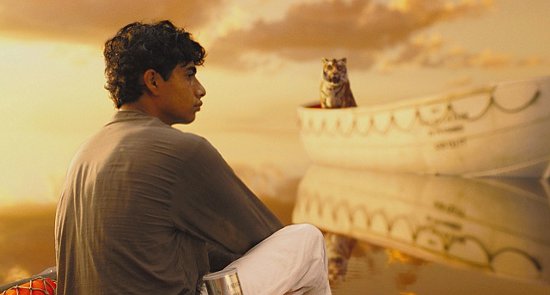
In any other film, a line such as “your mother is the orangutan” would sound like a vulgar schoolyard slur.
But in Ang Lee’s lavish spare-no-CGI adaptation of novelist Yann Martel’s best-selling lost at sea story about a boy who shares a lifeboat with a Bengal tiger, thus marking a level of odd couple freakishness matched in cinema only by Tom Hanks’ infamous bromance with a volleyball, it rolls warmly off an actor’s tongue in a poignant moment of reflection and meditation.
Ang Lee’s next challenge is to do the same with a “yo’ mother is so fat” joke, and — going by the jaw-dropping success of this, his 12th feature film — I wouldn’t put it past him.
Perhaps Life of Pi’s greatest achievement (there are several) is to finally and spectacularly lay to rest the notion that any book is “unfilmable”. David Cronenberg landed some blows with Naked Lunch (1991), Terry Gilliam severed limbs in Fear and Loathing in Las Vegas (1998) and now Lee, using a much more classical style, has killed it for good. A stunningly decorated cathedral of atmospheric indulgence is the box he buried it in.
You won’t see the “actor” who “plays” Pi’s Richard Parker at the Academy Awards ceremony next February, but plenty of his colleagues will be there. Parker is the aforementioned tiger with whom 16-year-old Pi (Suraj Sharma) shares an expectantly difficult relationship in a story modestly described to one character as something “that will make you believe in God”.
In bookend sequences an adult Pi (Irrfan Khan) recounts his incredible tale, beginning with religious experimentations that dotted his childhood to the grim circumstances that led to him bobbing in the ocean with the sharp-toothed Mr Parker. The first act is largely about Pi’s promiscuous approach to religion, which adds a spiritual heft to the journey when the cast shrinks to two and this extraordinary film catches its breath.
Relishing in the gorgeous life-like rendering of animals strewn throughout Life of Pi, one can’t help but sense that some kind of high water mark has been reached, a level of technical prowess capable of combining live action and CGI with yet to be paralleled aplomb. Perhaps even of making the much derided 3D format worth it.
This is not, however, the next Avatar. Anybody familiar with Lee’s oeuvre understands he’s not in this game to collect visual effects kudos; the director of Crouching Tiger, Hidden Dragon (2000) and Eat Drink Man Woman (1994) has a grace behind the lens that more than matches the now majestic mise en scene in front of it. If Life of Pi’s closing bookend feels a mite mawkish in the way it contextualises the film’s story, all is quickly forgiven. Several scenes, for want of a better word, are unforgettable.
Floating in the middle is a hallucinatory sequence involving swirling patterns, underwater animals and the face of a woman lit in intergalactic-looking blues and purples. It’s easily one of the most gorgeous things I’ve seen at the cinema in years. At the peak of its atmospheric powers Life of Pi is an exquisite hymn to the power of cinematic escapism, punctuated by moments of visual bravado that border on the indescribably beautiful. Whatever you do, see it on the big screen.
Life of Pi’s Australian theatrical release date: January 1, 2013.







Crikey is committed to hosting lively discussions. Help us keep the conversation useful, interesting and welcoming. We aim to publish comments quickly in the interest of promoting robust conversation, but we’re a small team and we deploy filters to protect against legal risk. Occasionally your comment may be held up while we review, but we’re working as fast as we can to keep the conversation rolling.
The Crikey comment section is members-only content. Please subscribe to leave a comment.
The Crikey comment section is members-only content. Please login to leave a comment.